KV-2 — The Soviet Union’s Red Colossus
December 2nd, 2023
12 minute read
During Operation Barbarossa, in action near Raseiniai, Lithuania, the German 6th Panzer Division was held up for most of two days at the bridgehead by a single Soviet tank. This was no ordinary tank that could slow an entire Panzergruppe in its advance on Leningrad. It was the KV-2 heavy tank, a massive “colossus” of an armored assault gun. During these difficult hours, the KV-2’s thick armor turned away the German’s latest anti-tank weapons and defied the best efforts of the Panzertruppen.
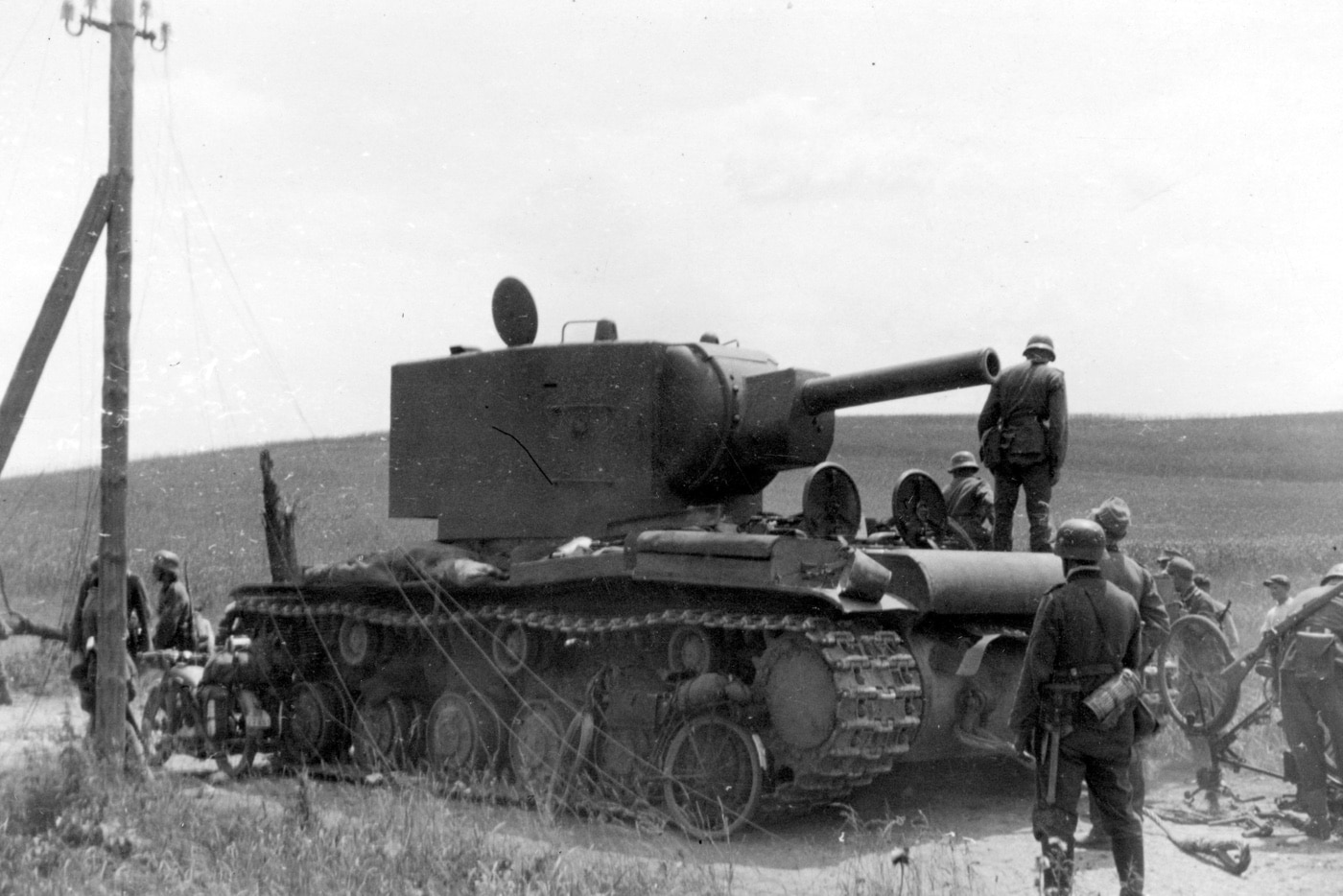
The KV-2’s 152mm gun blasted away Germany’s latest 50mm AT guns, vainly detailed to knock out the Soviet giant. German reports spoke of the KV-2’s armor plates glowing red after repeated strikes from the 50mm AP shells skipping off the 110mm armor on the turret front, and 75mm armor on the hull front and turret sides. German field artillery was brought up, the howitzers firing at the armored giant over open sights to no avail. The final answer came in the form of multiple 88mm AA guns, de-tracking the vehicle and achieving a few penetrations to temporarily incapacitate the crew. Even so, the KV-2 did not submit and was finally subdued by a close assault by German combat engineers.
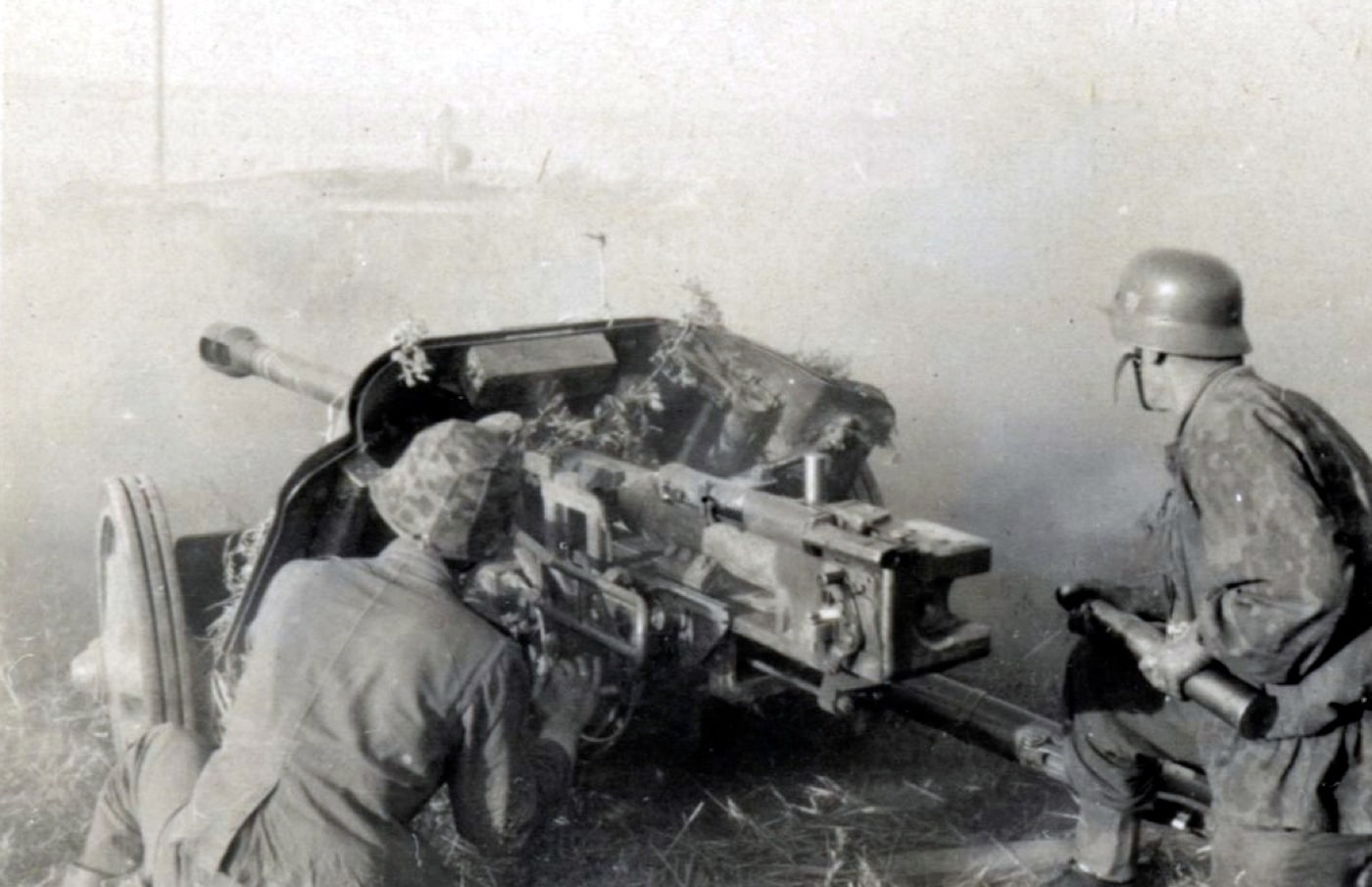
That the KV-2 could turn away almost any German anti-tank weapon and dominate the battlefield with impunity represented a massive wake-up call to the Reich’s weapon designers. The KV-2 created a response from the Germans far out of proportion with its actual combat effectiveness and it is among the vehicles directly responsible (including the T-34 and KV-1 tanks) for initiating rapid advances in German anti-tank weapons, as well as the development of heavy tanks like the medium “Panther” and the “Tiger” heavy tank.
The Source
The KV-2 was essentially a “war baby”. Soviet experience in the Winter War against Finland (1939-1940) showed a need for a heavily armed and armored assault vehicle that could engage well-constructed bunkers. The new KV heavy tank hull was selected, and a massive turret containing a 152mm howitzer installed.
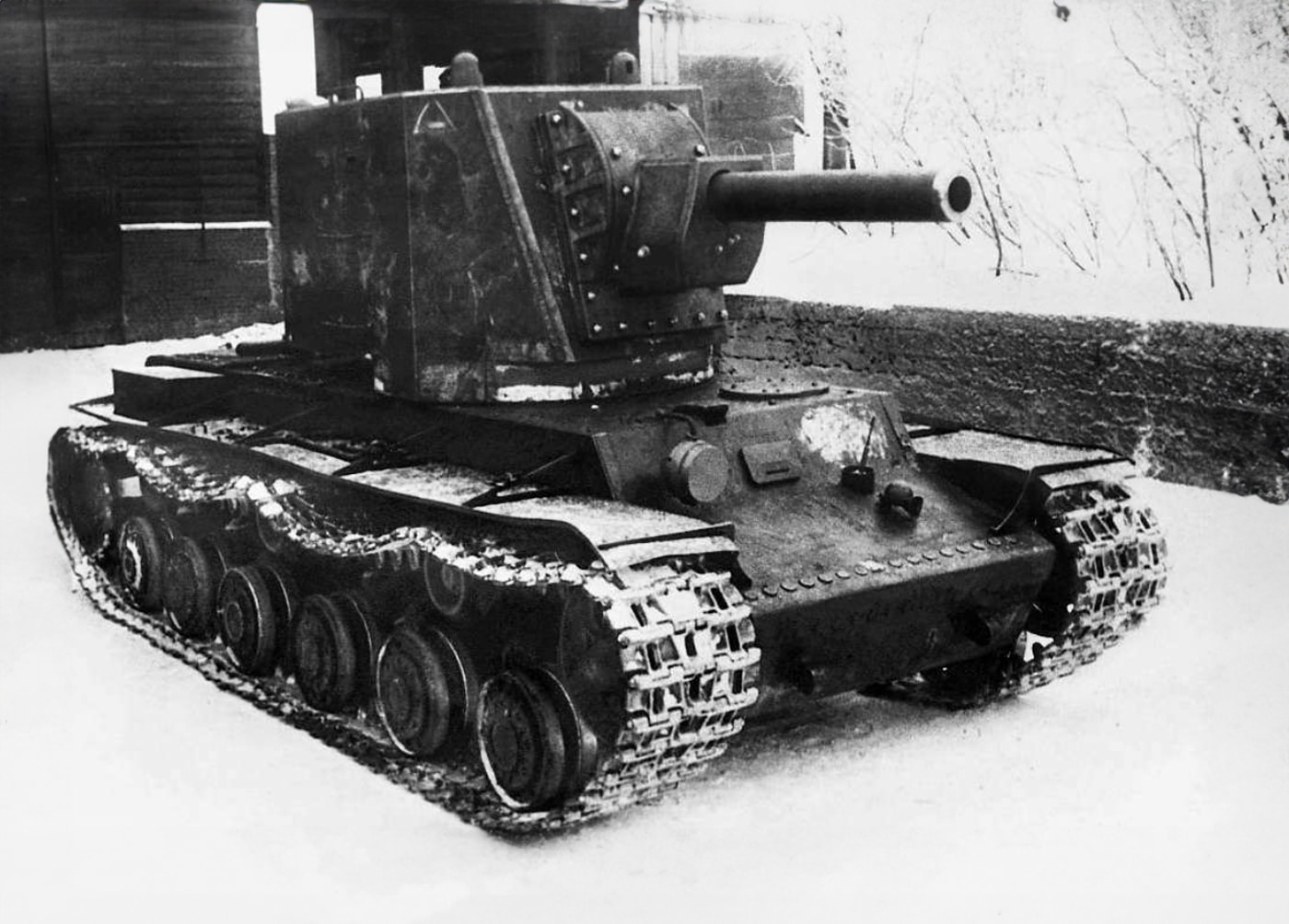
In 1940, a pair of pre-production KV-2s were sent to the Karelian Isthmus area to be tested against captured Finnish bunkers. The results of the test were satisfactory, and the Red Army accepted the KV-2 into service. Interestingly, the Soviets originally dubbed the KV-2 as “the KV with the large turret”, as opposed to the KV-1 MBT, which was the “KV with the small turret”. Clerks and typists throughout the Red Army rejoiced when the nomenclature was simplified to KV-1 and KV-2.
During production, the massive turret (four feet, nine inches high) was improved slightly, and an additional DT 7.62mm MG was added in a ball mount to cover the rear of the vehicle. The KV-2’s 152mm M-10 howitzer fired a 51kg HE projectile with muzzle velocity of 1,430 feet per second. Russian sources quoting the KV-2 manual claim that only HE ammo (with a reduced propellant charge) was used in the main gun. The power of the propellant charge in armor-piercing and concrete-piercing ammunition caused excessive recoil in the 152mm howitzer, upsetting the KV-2’s turret balance and leading to jams.
Designed as a bunker-busting assault vehicle, the ponderous KV-2 was soon out of place in the fluid armored actions on the Russian front — operations that demanded speed and maneuverability. The KV-2 turret was incredibly heavy, and it proved almost impossible to traverse when not on level ground. Its engine and transmission struggled to propel the great bulk of the vehicle, and many of the KV-2’s lost were due to mechanical breakdowns. Estimates vary on the total number produced, but little more than 200 were ever manufactured before production was cancelled during October 1941.
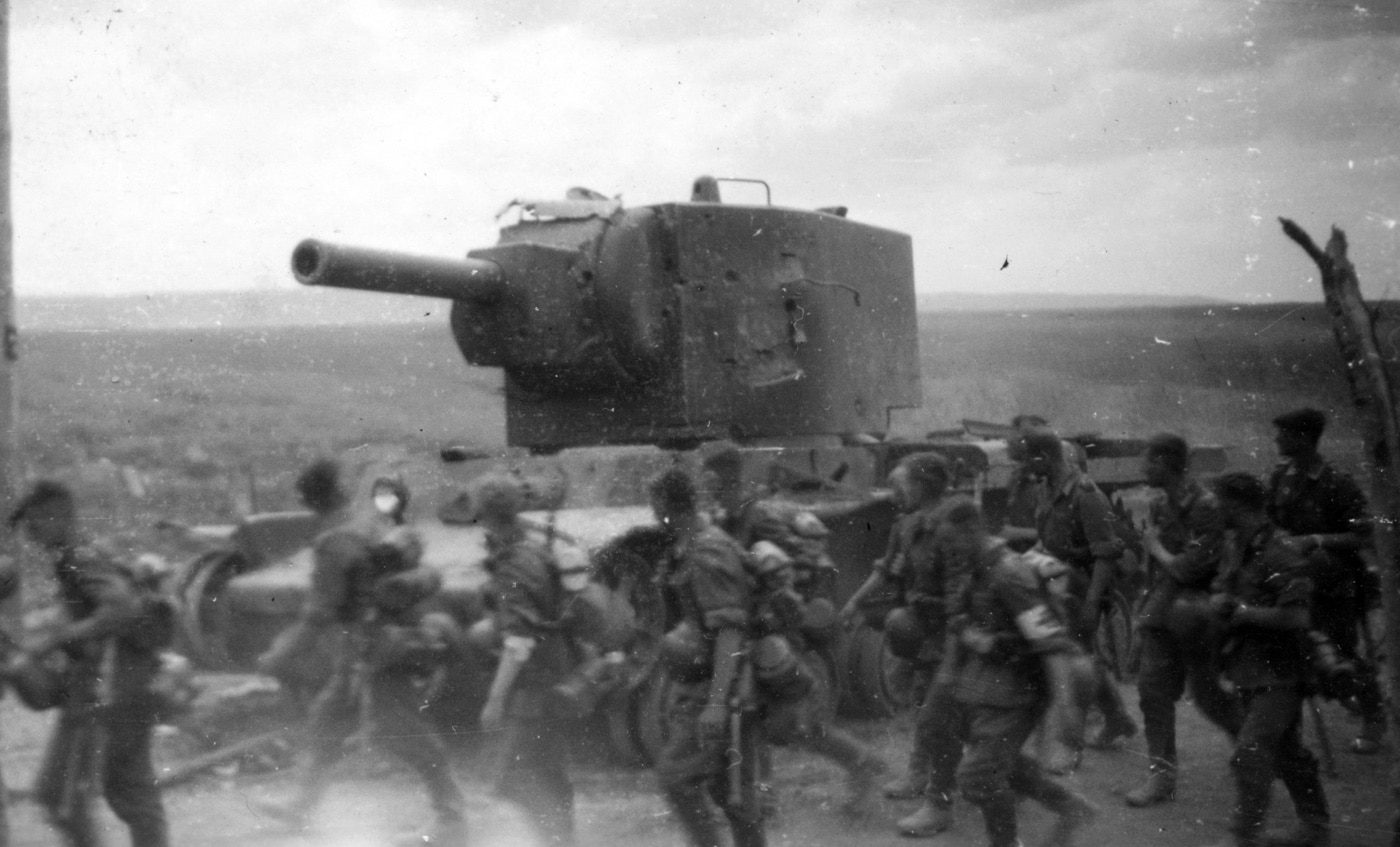
The Germans were quite impressed with the KV-2, and they took several captured examples into service. KV-2s used by the Germans were known as (Sturm)Panzerkampfwagen KV-II 754(r). In German service, a commander’s cupola from a Panzer III or IV was added to the top of the KV-2 turret. There has been some discussion that the Germans intended to use a small group of captured KV-2s in their proposed invasion of Malta, or in the ambitious concept of an assault on Gibraltar.
Unstoppable?
Despite the KV-2’s problems with mobility, there were incidents during the summer and fall of 1941 when German troops found themselves without weapons powerful enough to knock out the Red Army’s colossus. The following account comes from a U.S. Army report titled “Small Unit Actions during the German Campaign in Russia”, which was translated and compiled in July 1953.
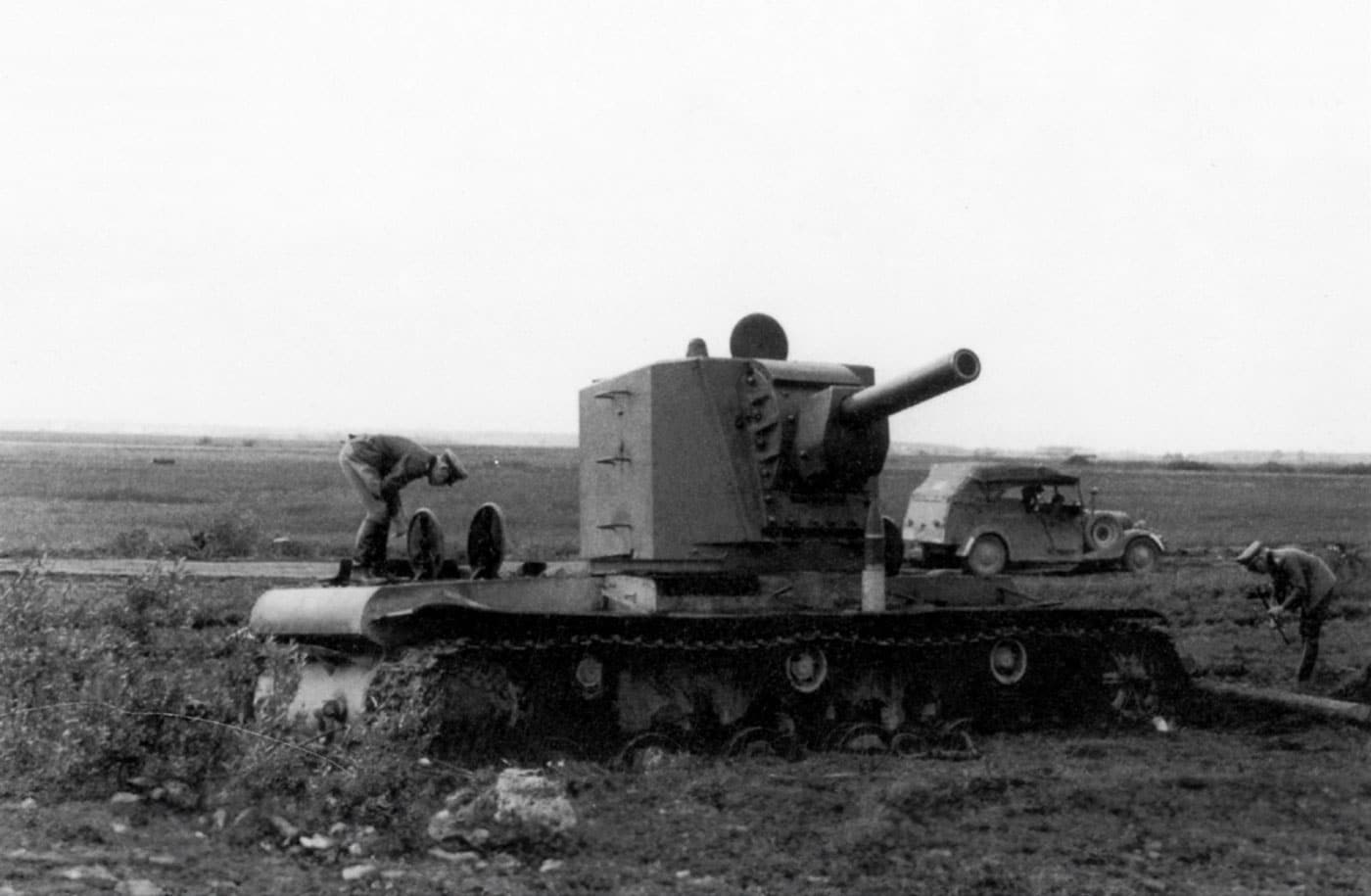
A section called “The Armored Roadblock (June 1941)” details the action on the Lithuanian border, where a single KV-2 held up the advance of the German 6th Panzer Division for nearly two days.
Army Group North jumped off from positions along the border separating East Prussia from Lithuania. On D plus 1 the 6th Panzer Division, which was part of Army Group North, was ordered to occupy the Lithuanian town of Rossienie and then to seize the two vehicular bridges across the Dubysa River northeast of the town…
…The sergeant and the driver returned to the bridgehead with the empty truck and informed their commanding officer that the only supply route to the bridgehead was blocked by a heavy tank of the KV type. The Russian tank crew had meanwhile severed telephone communication between the bridgehead and the division command post.
The Russian plan was not clear. In estimating the situation, the bridgehead commander felt that because of the encounter with the tank an attack against the rear of the bridgehead was to be expected; accordingly, he organized his force immediately for all-around defense. An antitank battery was moved to high ground near the command post, one of the howitzer batteries reversed its field of fire to face southwestward, and the engineer company prepared to mine the road and the area in front of the defense position. The tank battalion, which was deployed in a forest southeast of the bridgehead, prepared for a counterattack.
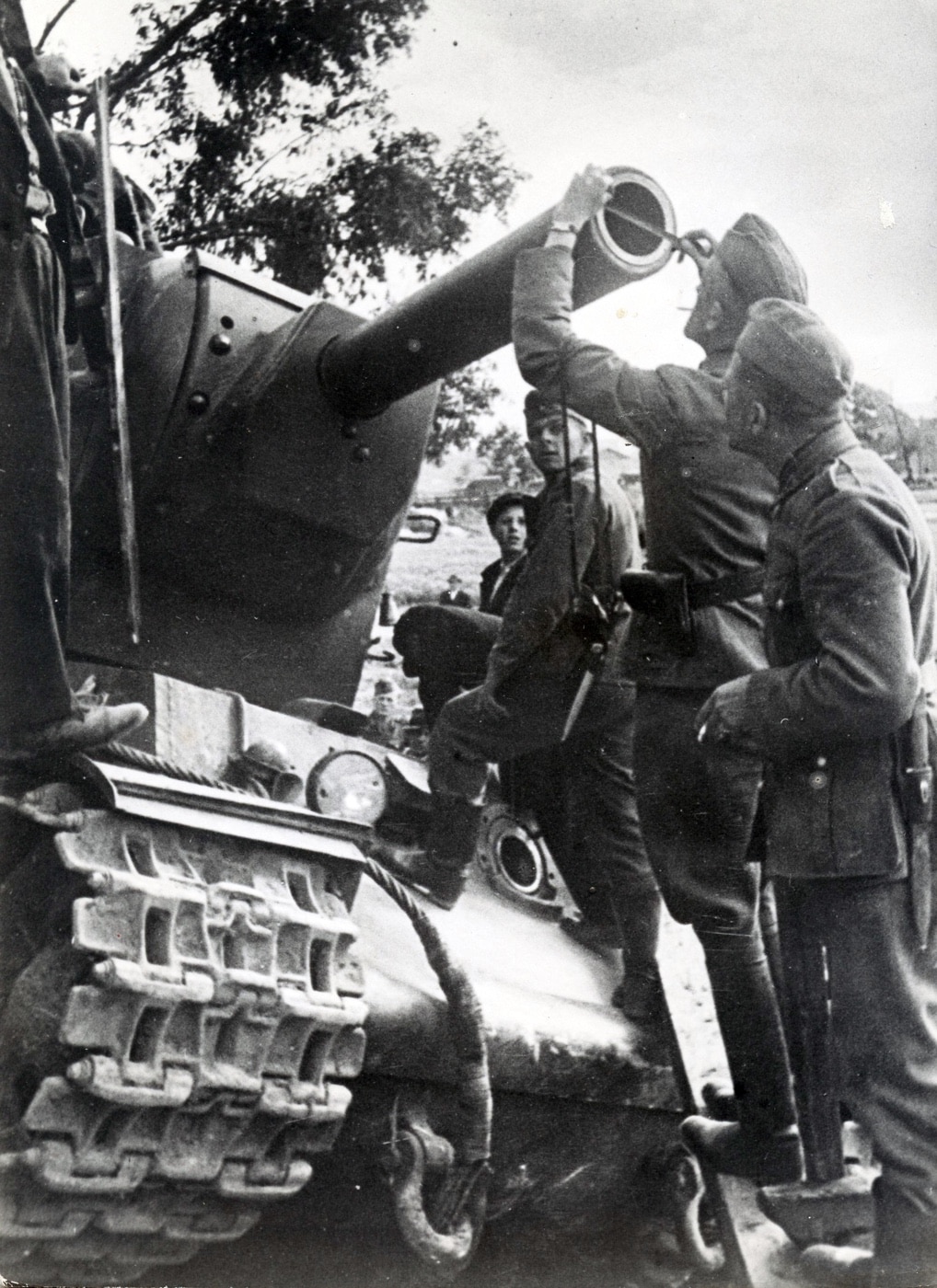
During the rest of the day the tank did not move. The next morning, 24 June, the division tried to send 12 supply trucks from Rossienie to the bridgehead. All 12 were destroyed by the Russian tank. A German reconnaissance patrol sent out around noon could find no evidence that a general Russian attack was impending.
The Germans could not evacuate their wounded from the bridgehead. Every attempt to bypass the tank failed because any vehicle that drove off the road got stuck in the mud and fell prey to Russians hiding in the surrounding forest.
On the same day, an antitank battery with 50-mm. guns was ordered to work its way forward and destroy the tank. The battery confidently accepted this mission. As the first guns approached to within 1,000 yards of the KV, it remained in place, apparently unaware of the German movement. Within the next 30 minutes the entire battery, well camouflaged, had worked its way to within firing range.
Still the tank did not move. It was such a perfect target that the battery commander felt that it must have been damaged and abandoned, but he nevertheless decided to fire. The first round, from about 600 yards, was a direct hit. A second and a third round followed. The troops assembled on the hill near the combat team’s command post cheered like spectators at a shooting match. Still the tank did not move. By the time that the eighth hit was scored, the Russian tank crew had discovered the position of the firing battery. Taking careful aim, they silenced the entire battery with a few shells, which destroyed two guns and damaged the others. Having suffered heavy casualties, the gun crews were withdrawn to avoid further losses. Not until after dark could the damaged guns be recovered.
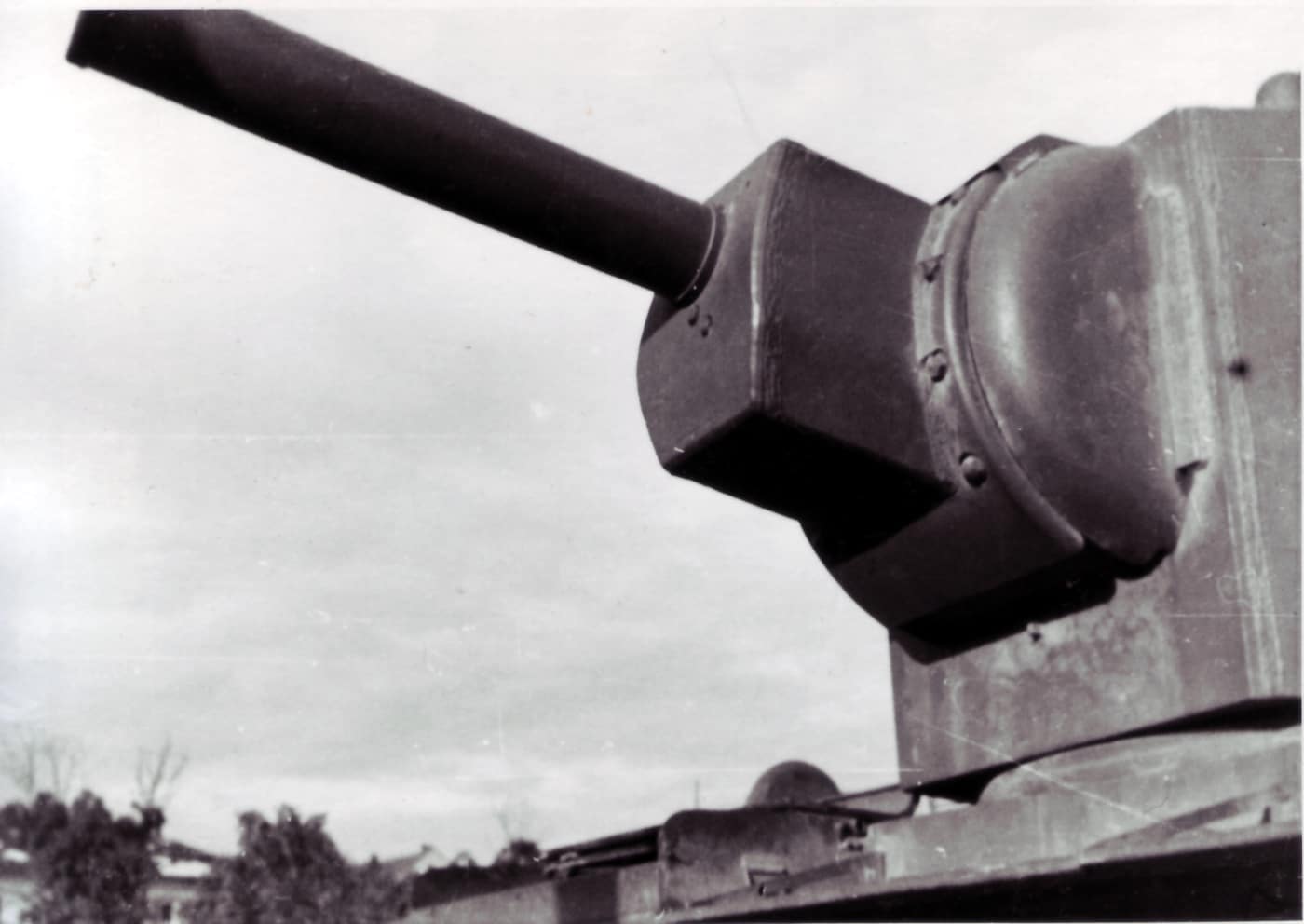
Since the 50-mm. antitank guns had failed to pierce the 3-inch armor, it was decided that only the 88-mm. flak gun with its armor piercing shells would be effective. That same afternoon an 88-mm. flak gun was pulled out of its position near Rossienie and cautiously moved up in the direction of the tank, which was then facing the bridgehead. Well camouflaged with branches and concealed by the burned-out German trucks lining the road, the gun safely reached the edge of the forest and stopped 900 yards from the tank.
Just as the German crew was maneuvering the gun into position, the tank swung its turret and fired, blasting the flak gun into a ditch. Every round scored a direct hit, and the gun crew suffered heavy casualties. Machine Gun fire from the tank made it impossible to retrieve the gun or the bodies of the German dead. The Russians had allowed the gun to approach undisturbed, knowing that it was no threat while in motion and that the nearer it came the more certain was its destruction.
Meanwhile, the bridgehead’s supplies were running so low that the troops had to eat their canned emergency rations. A staff meeting was therefore called to discuss further ways and means of dealing with the tank. It was decided that an engineer detachment should attempt to blow it up in a night operation.
When the engineer company commander asked for 12 volunteers, the men were so anxious to succeed where others had failed that the entire company of 120 volunteered. He ordered the company to count off and chose every tenth man. The detachment was told about its mission, given detailed instructions, and issued explosives and other essential equipment.
Under cover of darkness the detachment moved out, led by the company commander. The route followed was a little-used sandy path which led past Hill 400 and into the woods that surrounded the location of the tank. As the engineers approached the tank, they could distinguish its contours in the pale starlight. After removing their boots, they crawled to the edge of the road to observe the tank more closely and to decide how to approach their task.
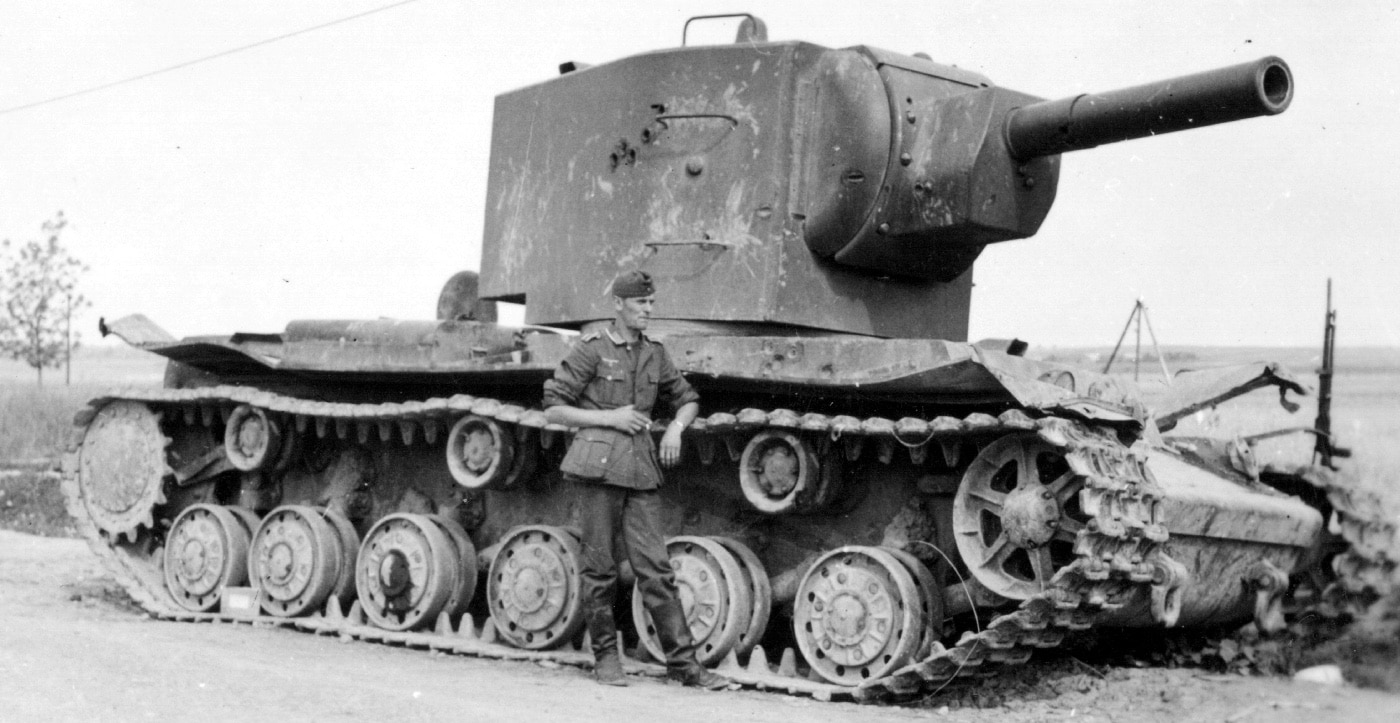
Suddenly there was a noise from the opposite side of the road, and the movement of several dark figures could be discerned. The Germans thought that the tank crew had dismounted. A moment later, however, the sound of tapping against the side of the tank was heard and the turret was slowly raised. The figures handed something to the tank crew, and the sound of clinking dishes could be heard. The Germans concluded that these were partisans bringing food to the tank crew. The temptation to overpower them was great, and it probably would have been a simple matter. Such an action, however, would have alerted the tank crew and perhaps wrecked the entire scheme. After about an hour the partisans withdrew, and the tank turret was closed.
It was about 0100 before the engineers could finally get to work. They attached one explosive charge to the track and the side of the tank and withdrew after lighting the fuse. A violent explosion ripped the air. The last echoes of the roar had hardly faded away when the tank’s machine guns began to sweep the area with fire. The tank did not move. Its tracks appeared to be damaged, but no close examination could be made in the face of the intense machine gun fire. Doubtful of success, the engineer detachment returned to the bridgehead and made its report. One of the twelve men was listed as missing.
Shortly before daylight a second explosion was heard from the vicinity of the tank, again followed by the sound of machine gun fire; then, after some time had passed, silence reigned once more.
Later that same morning, as the personnel around the command post of Combat Team R were resuming their normal duties, they noticed a barefoot soldier with a pair of boots under his arm crossing the bivouac area. When the commanding officer halted the lone wanderer, all eyes turned to watch. The colonel was heard asking the soldier for an explanation of his unmilitary appearance. Soon the sound of their voices became inaudible as the two principals in this little drama engaged in earnest conversation.
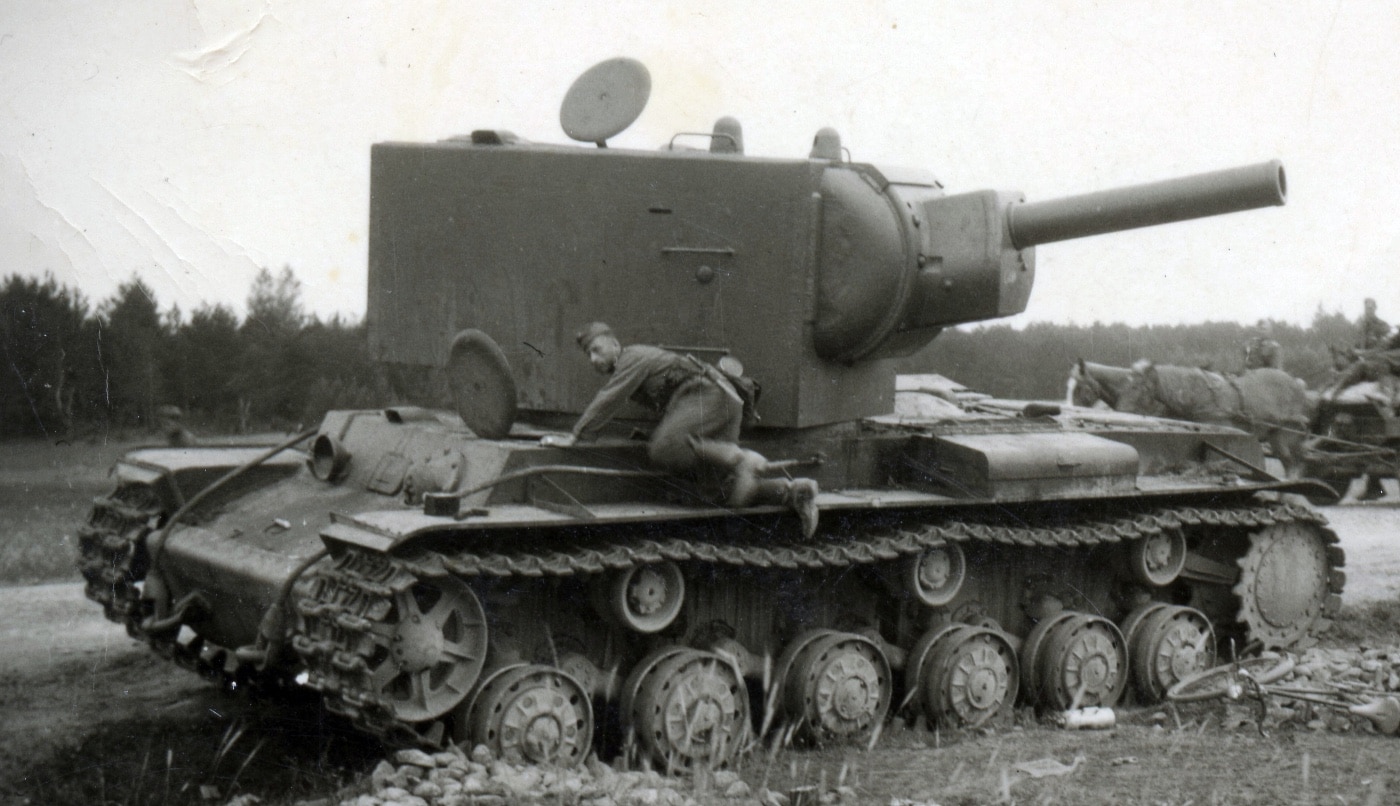
As they talked, the colonel’s face brightened, and after a few minutes he offered the soldier a cigarette, which the latter accepted, visibly embarrassed. Finally, the colonel patted the soldier on the back, shook his hand, and the two parted, the soldier still carrying his boots. The curiosity of the onlookers was not satisfied until the order of the day was published, together with the following extract from the barefoot soldier’s report:
“I was detailed as an observer for the detachment that was sent to blow up the Russian tank. After all preparations had been made, the company commander and I attached a charge of about double the normal size to the tank track, and I returned to the ditch which was my observation post. The ditch was deep enough to offer protection against splinters, and I waited there to observe the effect of the explosion. The tank, however, covered the area with sporadic machine gun fire following the explosion. After about an hour, when everything had quieted down, I crept to the tank and examined the place where I had attached the charge. Hardly half of the track was destroyed, and I could find no other damage to the tank. I returned to the assembly point only to find that the detachment had departed. While looking for my boots I found that another demolition charge had been left behind. I took it, returned to the tank, climbed onto it, and fastened the charge to the gun barrel in the hope of destroying at least that part of the tank, the charge not being large enough to do any greater damage. I crept under the tank and detonated the charge. The tank immediately covered the edge of the forest with machine gun fire which did not cease until dawn, when I was finally able to crawl out from under the tank. When I inspected the effect of the demolition, I saw, to my regret, that the charge I had used was too weak. The gun was only slightly damaged. Upon returning to the assembly point, I found a pair of boots, which I tried to put on, but they were too small. Someone had apparently taken my boots by mistake. That is why I returned barefoot and late to my company.”
Three German attempts had failed. The tank still blocked the road and could fire at will. Plan 4, calling for an attack on the tank by dive bombers, had to be canceled when it was learned that no such aircraft could be made available. Whether the dive bombers could have succeeded in scoring a direct hit on the tank is questionable, but it is certain that anything short of that would not have eliminated it.
Plan 5 involved a calculated risk and called for deceiving the tank crew. It was hoped that in this way German losses would be kept to a minimum. A feint frontal attack was to be executed by a tank formation approaching from various points in the forest east of the road while another 88-mm. gun was to be brought up from Rossienie to destroy the tank. The terrain was quite suitable for this operation; the forest was lightly wooded and presented no obstacle to tank maneuver.
The German armor deployed and attacked the Russian tank from three sides. The Russian crew, clearly excited, swung the gun turret around in an effort to hit the German tanks which kept up a continuous fire from the woods.
Meanwhile, the 88-mm. gun took up a position to the rear of the tank. The very first round was a direct hit and, as the crew tried to turn the gun to the rear, a second and a third shell struck home. Mortally wounded, the tank remained motionless, but did not burn. Four more 88-mm. armor-piercing shells hit their mark. Then, following the last hit, the tank gun rose straight up as if, even now, to defy its attackers.
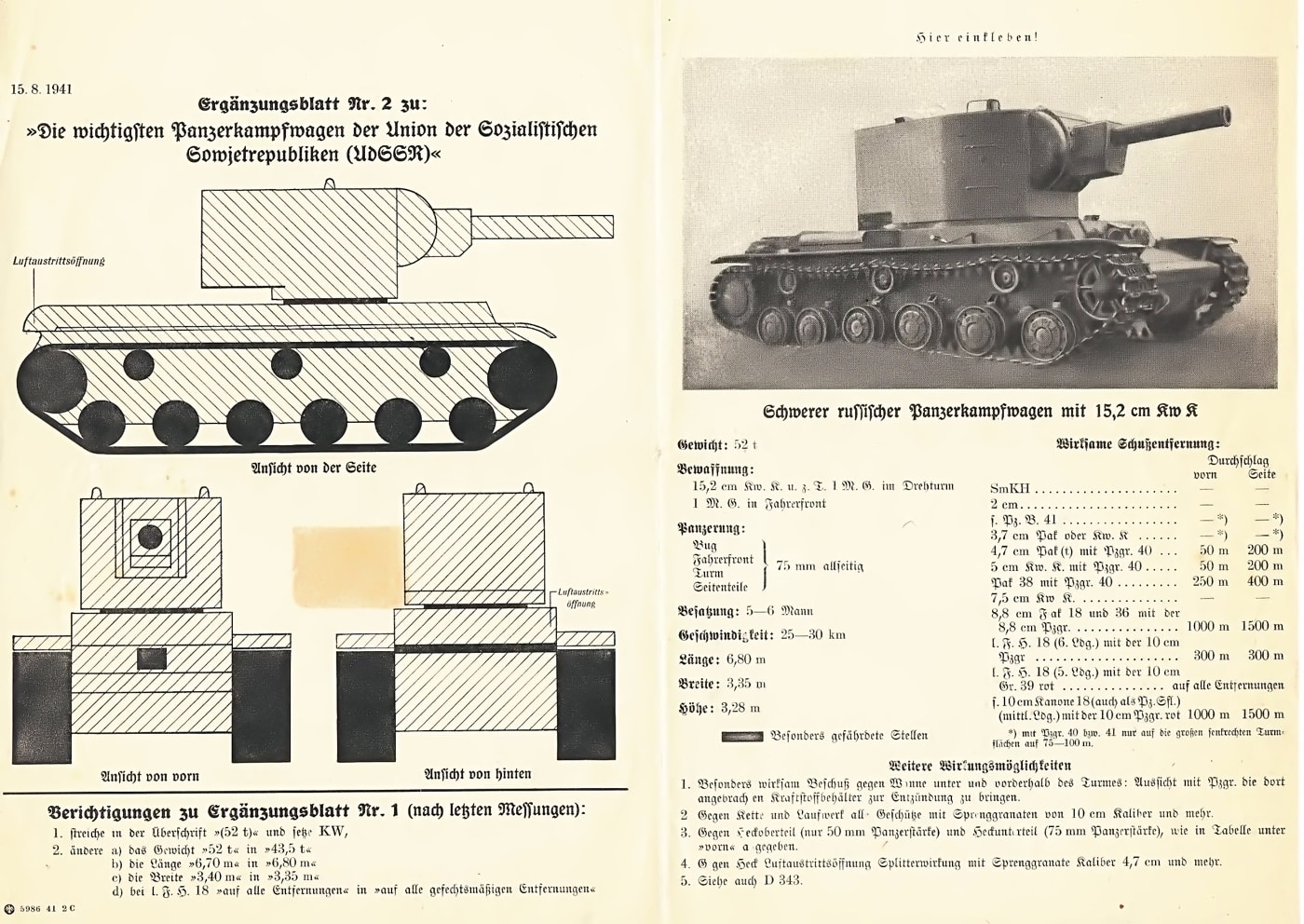
The Germans closest to the tank dismounted and moved in on their victim. To their great surprise they found that only two of the 88 mm. shells had pierced the tank armor, the five others having made only deep dents. Eight blue marks, made by direct hits of the 50-mm. antitank guns, were found. The results of the engineer attack had amounted to only a damaged track and a slight dent in the gun barrel. No trace of the fire from the German tanks could be found.
Driven by curiosity, the German troops climbed onto the tank and tried to open the turret, but to no avail. Suddenly, the gun barrel started to move again and most of the Germans scattered. Quickly, two engineers dropped hand grenades through the hole made by the hit on the lower part of the turret. A dull explosion followed, and the turret cover blew off. Inside were the mutilated bodies of the crew.
The Germans had come off poorly in their first encounter with a KV at this point of the front, one single tank having succeeded in blocking the supply route of a strong German force for 48 hours.
Editor’s Note: Please be sure to check out The Armory Life Forum, where you can comment about our daily articles, as well as just talk guns and gear. Click the “Go To Forum Thread” link below to jump in and discuss this article and much more!
Join the Discussion
Continue Reading
Did you enjoy this article?

 371
371






